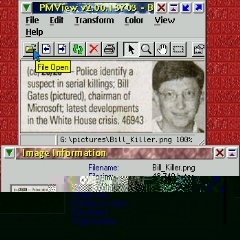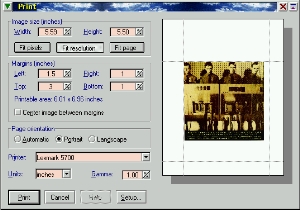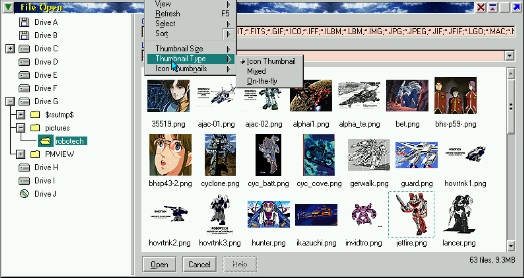

OS/2 has always had a certain edge when it came to graphics manipulation programs.
We may not have Adobe Photoshop (though I hear GIMP/2 for the XFree86-OS/2 GUI is
coming along nicely), but we've had a major contender for the scanning/viewing/editing
market in our corner for years -- PMView.
In its earlier days, PMView was a highly Workplace Shell integrated application
with a reasonably quick viewer and numerous handy features for touching up scanned
images. It also had a handy TWAIN interface which allowed scanner support to be
added. At the time, PMView's closest competitor in the Windows market was a little
program called Graphics Workshop by a British company (Alchemy Mindworks). PMView
had several advantages, however, since it was based upon OS/2's Extended Attributes
and WPS drag and drop functionality.
Around the summer of 1998, there was word of a forthcoming PMView 2.0 release
to be developed for both OS/2 and Win32 (Win9x/NT), and by the beginning of 1999
there was a beta test available for registered users of version 1.xx.
As is the case for any major undertaking in software, there were numerous bugs
which needed to be worked out and several features which were not fully implemented.
Peter Nielsen, PMView's developer, has done a fabulous job of updating the PMView
2.0 beta over the past two months. As a beta tester, I can attest to the tremendous
advances that have been made to the interface, the speed, and the overall usability
of this product.
 The
new features in PMView 2.0 are astounding! The user interface is far more configurable
than 1.xx, with the user having the option to enable or disable any part of it (title
bar, menu bar, tool bar, status bar, etc). There are now several tools available
on an icon tool bar, including zoom and the familiar selection tool (for cropping
images) as shown in the image at left. You will also notice the Win95-like "grips"
at the lower-right corner of the main viewer window. These serve no real purpose,
since you can already resize OS/2 windows by dragging any of their corners, but
the space would go unused otherwise, so why not? This ought to also create a consistency
in the look/feel of the OS/2 and forthcoming Win32 versions of the program.
The
new features in PMView 2.0 are astounding! The user interface is far more configurable
than 1.xx, with the user having the option to enable or disable any part of it (title
bar, menu bar, tool bar, status bar, etc). There are now several tools available
on an icon tool bar, including zoom and the familiar selection tool (for cropping
images) as shown in the image at left. You will also notice the Win95-like "grips"
at the lower-right corner of the main viewer window. These serve no real purpose,
since you can already resize OS/2 windows by dragging any of their corners, but
the space would go unused otherwise, so why not? This ought to also create a consistency
in the look/feel of the OS/2 and forthcoming Win32 versions of the program.
Note also in the screenshot to the left that the mouse pointer is visible. This
ability to capture the mouse with a screenshot is another new feature in 2.0.
Furthermore, every menu item in PMView 2.0 has configurable hot-keys. The last
page of the properties notebook lets the user tailor the features to his/her own
liking. If you want Save As... to be mapped to Shift-Alt-I then so be it. If you
inadvertently try to set one feature to an existing key assignment, PMView alerts
you of the existing assignment and asks if you really want to make the change. There
is also a button to quickly set the hot-keys back to their 1.xx mappings.
 The
vastly enhanced print properties page (now one page instead of three) makes it a
snap to define both the size and position of the printed image (shown at right).
In this example, I am printing an image in portrait mode on an 8.5 x 11 inch page
with a 1.5 inch left margin and a 3 inch top margin. I could have selected the Fit
Page button near the top to enlarge the image to the full printable area (between
the margins) without mangling the image's proportions -- in other words, if it reaches
the margins in width but has not reached the margins in height, it doesn't stretch
the image. I also could have easily selected to print the image in Landscape mode
for a wider but shorter printable area.
The
vastly enhanced print properties page (now one page instead of three) makes it a
snap to define both the size and position of the printed image (shown at right).
In this example, I am printing an image in portrait mode on an 8.5 x 11 inch page
with a 1.5 inch left margin and a 3 inch top margin. I could have selected the Fit
Page button near the top to enlarge the image to the full printable area (between
the margins) without mangling the image's proportions -- in other words, if it reaches
the margins in width but has not reached the margins in height, it doesn't stretch
the image. I also could have easily selected to print the image in Landscape mode
for a wider but shorter printable area.
Perhaps the most startling visual difference from version 1.xx to 2.xx is the
File Open Container (shown below). In v1.xx, the FOC was drag'n'drop enabled only
from/to the actual file container, and not the drive or directory boxes which were
along the right side. In v2.0, the drive/directory box (singular) is along the left
of the FOC and is fully drag'n'drop capable. You can, for instance, drag files from
one directory to another all from within PMView.
Be prepared, though. Due to some "outdated" portions of IBM's OS/2
development tools, some portions of PMView's FOC may not work quite as you would
expect. For one, the +/- buttons next to drive and directory names in the tree cannot
be accurately displayed unless the program scans every drive and directory upon
first access. This would tend to cause a bit of a hang in PMView while it populated
the tree, accessing every drive including removable (which tend to be slower) drives.
Note how long OS/2's own Drives folder takes to populate a single drive and then
multiply that by the number of drives on your system -- some people actually do
have drive letters up to or beyond N or O, though I've never personally seen anything
higher than that. Instead PMView 2.0 only notes the existence of subdirectories
upon access to a given drive within the tree.

Many more new features are packed into the updated File Open Container! Thumbnail
images can now be set in icon format (as in version 1.xx) which are held in the
Extended Attributes of the image file, or they can be produced on-the-fly and held
in memory. The latter being useful for viewing images on read-only media or across
a network. You also can now force the FOC to float on top rather than vanishing
from view when you open an image.
Bad news? Did I say bad news? I meant good news! The good news is that most of
the bugs reported during the beta test period have been fixed and the few remaining
bugs are being worked on prior to release.
For me, the PMView 2.0 beta test versions load somewhat slower than version 1.04.
In a test of 10 random images on my hard drive, with each image being loaded into
a fresh session via the Drives folders, PMView 2.0 loaded pics between 2 and 4 seconds
slower than 1.04 did. Nine of the ten test images were between 300x400 pixels and
800x600 pixels. The average load speed for PMView 1.04 was 3 seconds and for 2.0
beta 7 was 5 seconds. The most appalling difference came from the tenth image which
was scanned in at 600dpi. The image, 2961x3933 pixels, loaded in 96 seconds in PMView
2.0 but in only 19 seconds in PMView 1.04!*
Some of this difference, most assuredly the 2 second difference in the smaller
images, can be attributed to v2.0 using one large EXE file rather than dynamically
linked libraries and a smaller EXE as in v1.04. Some of the rest of the speed difference
can be attributed to this still being pre-release code with some significant changes
in output quality and features. One advantage to the use of a single large EXE file
is, of course, that you don't need the DLL files to be in your LIBPATH. For many,
this will save a reboot after installing PMView 2.0.
Despite still being in beta testing, this product is sufficiently usable as a
replacement to v1.04, which was the last officially released PMView.
The only bad news is that you should expect the few small problems that a nearly
complete re-write and the addition of several score new features always bring to
a program. Don't expect PMView version 2.0 to wash your laundry, but do expect it
to make a big impression on you. I'm told the laundry washing part is expected in
version 3. *grin*
I could go on for hours about the new features in PMView 2.0, but the internet
does have a bandwidth limit. *grin* I've barely scratched the surface here, but
it ought to be enough to convince most people that quality OS/2 software development
is still in effect and continues to leapfrog the popular Win32 development. For
a more complete list of features, bug fixes, and further screenshots, visit the
home of PMView (http://www.pmview.com/).
At the time of this writing, PMView 2.0 has not been released to the general
public and so the old 1.x licensing scheme is still in effect -- lifetime license
for US$40. As of the release of version 2.0, the license is to be changed, probably
to a "per major version" registration.
After all is said and done, PMView 2.0 for OS/2 is a major upgrade from version
1.xx. I cannot think of a better graphical manipulation program anywhere for any
operating system. However Win32 will eventually get its own version of PMView 2.0.
I would have to install Win32 to my system in order to comparison test the two,
and that's something that's just slightly too much to ask of me.
* System Specs: The system used for this was a Cyrix 6x86
P166+ with 32megs of EDO RAM, an S3 Trio64V+ based graphics card with 2megs of EDO
RAM running S3's v3.03.16 drivers. 4.3GB E-IDE hard drive was used for the test.